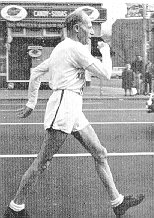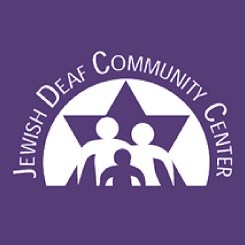 Morris Davis
Morris Davis
World’s Best Competitive Walker
Competitive walking is a track and field event that normally isn’t part of the track meet agendas. Maybe it is popular in Europe but not in USA. Anyway in the thirties, the late Morris Davis, who was deaf and a staunch member of the deaf Jewish community for many years, was a champion walker.
Wherever Morris went, he was lovingly referred to as the “champion walker.” It was not necessary to mention his name – just mention Champion walker,” and everyone knew who he was.
And he did not just compete in walking events only during his prime athletic years. He was a life-time walking contestant, even entering masters 5K and 10 K walking races right up to his death! His walking career lasted six decades. Only death put a stop to it.
How good was he as a champion walker? Well, he would have been an Olympian, except for one major technicality-he was born in England and emigrated to USA during his youth. During his prime walking years he was still a British citizen. In his lifetime Morris picked up over 150 medals and 250 trophies, while winning a number of walking events, both In USA and in England.
Morris won one national championship – the 1935 National AAU 15 kilometer championship. He also held a world record – the fastest 25 mile walk ever, clocking that distance in 3 hours, 43 minutes and 34 seconds. This feat took place on September 8, 1935.
Even as recent as age of 78 on November 28,1976, he finished 17th in a field of 54 in the Walkers’ Club annual 10-mile race that took place on the boardwalk of Coney Island in Brooklyn, NY.
He did participate in the “Olympics,” only it was the World Games for the Deaf in 1965 at Washington, DC. At that time Morris was 66 years old! And how he became a WGD athlete is an interesting tale. ~
Walking was on the 1965 WGD agenda; but because there were no active walkers among younger deaf athletes, Art Kruger, the USATeam Chairperson asked Davis to visit Gallaudet University and to try to recruit potential walkers among a large pool of male students. Davis accepted the challenge and he taught a group of approximately 20 students on the fundamentals of race walking. The group, at the start, were enthusiastic and thrilled at the opportunity to try out for the Games.
Unfortunately, as time passed by, everyone in the Gallaudet group dropped out, one by one, until there were no walkers left! Some of the Gallaudet walkers were great athletes but they just could not stand the constant strain of competitive walking.
Because of shortage of walkers, Art had no choice except to personally draft Morris to the USA/WGD team. Morris was still actively walking, but not in races against kids young enough to be his grand children! He only competed against walkers his age.
It would have been great to say that he won a medal. He didn’t – finishing out of money. There was no way he was going to keep apace with kids only one third of his age. Still his participation at the 1965 Games did the Americans a great honor. And for the rest of his life he cherished the opportunity to compete against the world’s best deaf walkers, those half of his age and even against a German walker who eventually took part in the hearing Olympics!
Morris owns a footnote, or even a piece of trivia in AAAD history. As a rule, athletes must have been retired from their main sport for at least five years before they could win induction into the AAAD Hall of Fame. Well, Morris was elected to the AAAD Hall of Fame in 1965, the same year he took part in the World Games for the Deaf! Either the rule was bent to accommodate him or the AAAD hall of fame electors overlooked the fact that Morris was still competing, and may have assumed wrongly that there was no way he would be still competing at his age!




